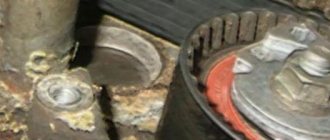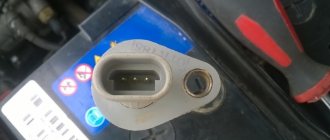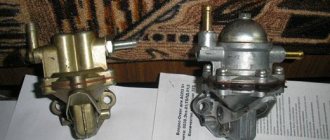Disassembling the module: replacing (cleaning) the fuel filter, fuel pump and fuel level sensor
The fine fuel filter (housing), the coarse filter (mesh), the fuel pump, and the fuel level sensor are located in the fuel module complex, which is located in the fuel tank.
Note: According to the regulations, replacement of individual parts of the fuel module is not provided, and in the event of failure of any of its components, the module is replaced as an assembly. However, in an emergency, to replace the fuel pump, clean the fuel filter, or replace the fuel level sensor, the module can be disassembled.
To disassemble the fuel module and replace parts, remove it from the vehicle. (see here)
Disconnect the fuel level sensor wire block from the cover
Remove the fuel level sensor by sliding it in the direction of the arrow
Fuel level sensor 1 – resistor; 2 – slider; 3 – sensor wire block; 4 – float; 5 – float lever
Using a screwdriver, press out the three plastic clips...
...and remove the glass from the fuel module body. Here is a fine fuel filter (housing) and a coarse mesh filter
Remove the rubber o-ring of the fuel pressure regulator.
The glass contains a fuel pressure regulator 1 and an anti-drainage valve 2 .
Having overcome the force of the clamps, remove the fuel strainer.
Wash, blow out, or replace the strainer
Note: to replace the fine filter, some car enthusiasts used a non-original filter with art. LF249M (see photos and dimensions)
Using a screwdriver, press the cover latch...
. answer the lid to the side
remove the spacer spring
Disconnect the fuel pump block from the connector on the inside of the cover.
Remove the fuel pump from the fuel filter housing.
Note: Fuel hoses are secured to the fittings of the pump and filter housing by heat shrink.
After heating the plastic corrugated tube on the pump nozzle, remove the tube from the pump nozzle. Use a stream of boiling water from a kettle or a hair dryer for this.
Attention : before using a hair dryer, thoroughly blow and dry the parts to avoid fuel ignition!
Note: After removing the hoses from the fittings, it may be necessary to replace the hoses to ensure a good seal. Some car enthusiasts used corrugated fuel pump hoses for VAZ.
To install and secure the hose on the fuel pump after removal, some car enthusiasts use regular clamps (but not the worm type)
11 mm. The clamp must be secured so as to ensure a tight connection and at the same time not crush the plastic hose.
We assemble and install the module in the reverse order.
Some misconceptions about the fuel pump (from Behind the Wheel magazine)
The slightest loss of pump seal will immediately lead to a fire, since its brushes constantly spark.
The gas pump is not a sealed structure, and its internal parts, such as the anchor or brushes, are constantly bathed in gasoline. But combustion is impossible: the concentration of fuel vapors is much higher than the stoichiometric one, and therefore it is impossible to ignite them.
Cars with fuel injection need to be refueled more often, but you can’t drive “with a light bulb” at all.
Many people believe that if the tank is not full, the pump will definitely start sipping air instead of gasoline and quickly die. The pump is placed in a plastic cup that prevents fuel from draining during acceleration and roll. The glass is pressed by a spring to the lowest point of the fuel tank. In addition, internal partitions in the fuel tank prevent the ebb and flow of gasoline. What if the fuel runs out? And there will be no troubles: as soon as the pump stops creating pressure, the engine will stall, and the controller will turn off the power in a couple of seconds.
A motor running “dry” instantly fails.
When the internal combustion engine stalls, power is removed from the electric fuel pump very quickly. Therefore, he does not have the physical ability to thresh for a long time in a “dry” mode. In addition, we ran the pumps “dry” for about ten minutes - and nothing: cold body, low current consumption, even noise. Therefore, the pump will not die from lack of gasoline.
Gasoline plays the role of a lubricant in the electric gasoline pump.
The lubricity of gasoline is negligible. It plays the role of a coolant rather than a lubricant.
Excessive pressure in the fuel line is harmful, so when replacing, it is strictly forbidden to install a more powerful fuel pump.
The bypass valve (pressure regulator) in the fuel module monitors the amount of pressure generated by the fuel pump, sending excess fuel back to the gas tank. Therefore, a more efficient pump will not cause any harm. It’s another matter if you installed a weaker engine than standard: when operating at maximum modes, the engine may not have enough fuel and it will begin to “shut up”.
On cars converted to gas, fuel pumps especially often break down.
There are horror stories on online forums: the gas pump on cars with gas equipment is always running, pushing gasoline in a small circle, and therefore fails more often. But this is a normal mode, no different from a working one. Trouble could arise only if there was a complete lack of gasoline in the tank, but this already resembles sabotage. However, the pumps are also not afraid of short-term dry operation.
Parameters of some gasoline pumps installed on Lada cars (operating modes) (tests of the journal Behind the Wheel)
Removal and repair of the Lada Largus electric fuel pump module
We remove the fuel pump module if the electric fuel pump fails completely or partially, the fuel pump filter is clogged, or the fuel gauge sensor is faulty.
Preparation for module removal largely depends on the car model.
To remove the module, we prepare the car for work.
It is advisable to remove the module so that the amount of fuel in the tank is less than half the tank.
1. If the car is a station wagon, then we tilt the rear row of seats forward for a five-seater configuration and the middle row for a seven-seater configuration.
2. Disconnect and lift the floor covering
If the car has a van body, then remove the trim from the middle pillar, on the right side.
Remove the right side of the body partition.
Remove the right front part of the cargo compartment floor.
3. Remove the plastic cover of the fuel tank hatch
4. Using a flat-head screwdriver, press out the clamp of the wiring harness block
5. Disconnect the block
6. Start the engine to relieve pressure in the fuel system and wait until it stalls.
After this, turn off the ignition and remove the negative terminal of the battery.
Squeeze the fuel pipe tip clamps and remove the tip from the fuel module fitting.
7. Unscrew the union, plastic nut using a mounting spatula
8. If the nut does not budge, you need to make a device from a rod and use this device to unscrew the union nut
9. Remove the union nut
10. Place a rag around the hole to prevent any remaining fuel from spilling onto the car parts.
Carefully remove the fuel module from the tank, removing the float of the level sensor.
Pour the remaining fuel from the module into a container prepared in advance.
11. Remove the rubber o-ring.
12. Disconnect the level sensor wire block.
13. Bend the level sensor clamp.
14. Remove the fuel level sensor.
15. Use a flat screwdriver to release the three glass latches, while prying up the glass
Gasoline pump Lada Largus (removal and installation)
If engine power decreases, increased noise occurs, or noise is periodically heard when the fuel pump is operating, then most likely the fuel pump has failed. Pre-check the pressure in the fuel supply system. If the pressure in the system is less than 3 kgf/cmg, this may be caused by a malfunction of the electric pump, fuel pressure regulator, or clogged filter elements. In some cases, the fuel pump module can be repaired, but to do this it must also be removed from the vehicle. If all indirect signs indicate that the pump is faulty, then it must be removed and replaced. You will find information on how to do this in this article.
Replacing the fuel pump Lada Largus (VAZ Largus)
If engine power decreases, increased noise occurs, or noise is periodically heard when the fuel pump is operating, then most likely the fuel pump has failed. Pre-check the pressure in the fuel supply system. If the pressure in the system is less than 3 kgf/cmg, this may be caused by a malfunction of the electric pump, fuel pressure regulator, or clogged filter elements. In some cases, the fuel pump module can be repaired, but to do this it must also be removed from the vehicle. If all indirect signs indicate that the pump is faulty, then it must be removed and replaced. You will find information on how to do this in this article.
Operations for removing the fuel pump Lada Largus
1. Reduce the pressure in the supply system. 2. Disconnect the wire from the negative terminal of the battery. 3. Remove the second row seat cushion. 4. Unscrew the two plastic nuts securing the air duct cover.
5. . remove the nuts.
6. and air duct cover
7. Unscrew the two plastic nuts securing the floor covering on the left and right.
8. Remove the lower edges of the left and right rear door seals from the sill flanges.
9. . and raise the floor covering in the rear seat area.
10. Use a special plastic mounting spudger or a flat-blade screwdriver to pry off the fuel module hatch cover.
eleven. . remove the cover and move it to the side.
12. Press the clamp of the wiring harness block.
13. . and disconnect the block from the fuel module connector.
14. Squeeze the fuel line tip mounting bracket.
15. . and disconnect the fuel line from the fuel module fitting.
16. Unscrew with a special key and remove the pressure ring of the fuel module. If you do not have a special wrench, use a hammer to lightly tap it tangentially through a drift to loosen the pressure ring of the fuel module and unscrew it by hand.
17. Remove the fuel module from the fuel tank and drain the fuel from it into a previously prepared container.
18. Remove the O-ring.
When installing, replace the O-ring with a new one.
19. Install the fuel module in the reverse order of removal.
Make sure that when you reinstall the fuel pump module into place, the marks on it and on the body match. (labels A and B)
Removal and repair of the Lada Largus electric fuel pump module
We remove the fuel pump module if the electric fuel pump fails completely or partially, the fuel pump filter is clogged, or the fuel gauge sensor is faulty.
Preparation for module removal largely depends on the car model.
To remove the module, we prepare the car for work. It is advisable to remove the module so that the amount of fuel in the tank is less than half the tank.
If the car has a van body, then remove the trim from the middle pillar, on the right side. Remove the right side of the body partition. Remove the right front part of the cargo compartment floor.
Changing the fuel filter on a Lada Largus with your own hands
The fine fuel filter on Largus station wagons and vans is built into the fuel pump module. According to the regulations, this filter must be changed together with the module, and the period between replacements is 160 thousand km. The Renault company, unlike VAZ, specifies an interval of 120 thousand, but the essence will be the same - replacing the fuel filter on the Lada Largus and Logan is carried out only with a pump. We will look at what can be done to get a completely usable, but still temporary solution. At the same time, it will be indicated how to replace the mesh filter.
If anyone doubts the presence of a “paper” filter, you can look at it from the inside. Here's a video.
Fuel filter device
The design of the fuel filter on the Largus is interesting, as for a car model from AvtoVAZ. The design has two filter fuel elements that are installed in the fuel pump system. Fine and coarse filters in tandem with a fuel pump are a one-piece design. This means that in the event of a breakdown, in most cases the unit is completely replaced. Taking this feature into account, AvtoVAZ made the fuel filter for Lada Largus reliable, high-quality and with a long service life.
The design of the fuel filter and fuel pump on the Lada Largus is complicated, so there is no point in considering individual elements. But, despite this, even an amateur motorist will be able to visually determine the degree of contamination.
Design of the fuel filter flask in the pump
What is outlined in the figure is the fine filter. Through mesh 2, fuel enters the pump, then it enters container 3. This container is connected to the ramp through the upper fitting and pipe. Connection 1 is also an important element, since it is connected to the return valve.
Fuel module disassembled
The return flow valve is built into the lower glass, and it allows you to relieve excess pressure.
By the appearance of part 3, you can always assess the degree of filter clogging. It's a pity that the container is non-separable. Unfortunately, it is pointless to look for the article number for part 3: the fuel filter on the Lada Largus is replaced as an assembly with the pump.
Replacing the fuel filter
- We fold back the stern seat cushion and open the hatch cover.
- Turn off the pump power fuse.
- We start the LADA Largus engine and give it the opportunity to exhaust the fuel present under pressure in the circuit. The unit will stall.
- Turn off the power by removing the terminals from the battery.
- Disconnect the fuel lines leading to the pump module.
- Unscrews the locking disc.
- Having freed the pump assembly inside the mounting socket, we remove it and replace it with a new analogue. If you only need to replace the mesh filter, perform this action.
- After assembling the structure using the reverse algorithm, we must check the tightness of the system.
Removing the fuel module
We will perform all the steps as if we were trying to replace a fuel pump:
- We tilt the sofa cushion and remove it. We lift the plastic hatch and move the carpet forward. Remove the round cover from the hole;
Getting rid of unnecessary details
Understanding electricity
First - the pipe, then - the clamp
By removing the module assembly, you can replace the mesh filter. Be careful not to lose the O-ring installed between the module and the tank.
Replacing the filter mesh
On the Lada Largus, the coarse fuel filter is a removable mesh in front of the pump. Replacing it will be simple:
- We snap off the glass latches (3 pcs.);
Let's start disassembling the module
The very first element in the fuel tract
Installation of all modules and components is carried out in the reverse order. If the mesh is not badly damaged, it can only be washed and dried. Car chemicals based on xylene or ethoxylated alcohols will help.
We disassemble the module in order to replace the filter
The main thing to remember: first disconnect the brown connector. Then remove the level sensor by unfastening the clamp with a screwdriver.
Disassembling the pump module
Similar clamps hold the top cover. Having removed it, disconnect the white connector (see photo). How to remove the lower part of the module is discussed in the previous chapter. But you will have to tinker with the nozzles: when putting them on or removing them, the fittings must be held above the steam.
The most difficult operation
No one was able to achieve results right away.
Instead of standard pipes, black, shiny and beautiful, you can buy corrugated hoses from a VAZ-2110 car. This replacement is proven.
What is the best way to deal with the flask?
On the Lada Largus, the fuel filter is a flask containing paper. This flask is not sold separately and cannot be replaced. But it can be cut to remove the filter element completely.
Fuel filter housing
At the last step, both halves are glued together, and drying is done under pressure (on ties).
For gluing, use any petrol-resistant sealant.
So, we have an “empty” filter housing that is being installed in place. After assembling the module, it can be used, but there is a condition: after 1000-2000 km the module will have to be replaced. Follow our advice if the engine has run for 150-160 thousand and you don’t feel sorry for it anymore.
What not to do!
It would seem that you can drive for a long time with a cleaned bulb, you just need to insert a new filter into the fuel line. This is usually done by taking a filter from Renault Logan (phase 1).
Fitting the filter into the line under the hood
It turns out this:
- If the flask is empty and an “external” filter is added, the engine starts and stalls after 2-3 seconds;
- If the flask has not been cleaned, adding a new filter is useless: the load on the pump increases, and that’s all.
Let the reader draw his own conclusions.
Alternative option
Below is a flask that looks almost the same as the original Lada Largus fuel filter.
JS Asakashi brand components
This flask can be installed instead of the standard one. You just need to shorten the fastening elements (tubes) by about 20 mm. We were talking about filters for Nissan cars:
- JS ASAKASHI FS22001
- JAPANPARTS FC-130S
- PATRON PF3924
Fuel filter part numbers
Let's name the fuel module part numbers here: 8200307403, 6001547605 and 6000591702. Renault also uses part number 172024388R. As for the mesh filter, there is no original article, but there are substitutes:
- MASUMA MPU025N
- NPA NP51109412
Selection of analogues
The fuel module can be produced under the following brands:
- BOSCH 0 986 580 957 or 0 986 580 369
- ERA 775120
- ASAM 30290
- PIERBURG 7.00468.77.0
Replacing the fuel pump assembly for Lada Largus
When the pressure in the Largus fuel system decreases, you should first of all pay attention to the performance of the fuel pump, since it is this part that is responsible for the normal operation of the system. If it turns out that the pressure is weak, then the reasons may be as follows:
- Reduced pump efficiency
- The mesh (strainer) of the fuel pump is clogged
If the problem is in the grid, then we change it to a new one, which you can read about in the following reviews on Lada Largus repairs. In the meantime, let's look at the procedure for replacing the assembled fuel pump module on Largus. And for this we may need the following tool:
- flat blade screwdriver
- two short screwdrivers (phillips preferred)
So, the fuel pump on Lada Largus cars is located in the gas tank, and to get to it, you need to remove the back seat and pry off the plastic plug, as is clearly demonstrated in the photo below:
After this, disconnect the power plug from the module.
Now, using two screwdrivers, press the fitting clamps on both sides and disconnect the fuel pipes from the pump.
Now all that remains is to unscrew the plastic ring that secures the fuel pump in the tank. This can be done either using a screwdriver, carefully twisting the ring counterclockwise, or using long-nose pliers to try to unscrew it.
Now you can easily remove the fuel pump module assembly, carefully removing it from the tank so as not to damage the fuel level sensor.
After this, you can replace the pump with a new one. You can change both the module assembly and the motor itself separately. The price of a new one can reach up to 8,000 for the original, and sometimes even more. Although, a non-original one can be bought from 4,000 rubles.
Replacing the fuel filter Lada Largus
Traditionally, two fuel filters are installed on Lada cars to purify gasoline. One of them is called a coarse filter (mesh) and is located in the fuel pump, and the other fine filter is in the form of a separate module (replaced after 10-20 thousand km), which is attached to the bottom of the car near the gas tank. Let's look at how to replace the Lada Largus fuel filter.
If you open the “do-it-yourself repair manual for Lada Largus”, then in the “power system” section you will not find the usual instructions for replacing the fuel filter. The fact is that both filters (coarse and fine) are built into the fuel module (gasoline pump) . If it is not difficult to clean or change the fuel pump mesh, then replacing the Lada Largus fine fuel filter will not work; it is only replaced as an assembly with the fuel pump after 120 thousand km. mileage
- fuel pump mesh (articles: FRANCECAR FCR210141, MASUMA MPU025N, NPA NP51109412)
- fine filter (JS ASAKASHI FS22001, JAPANPARTS FC-130S, PATRON PF3924)
To remove the Lada Largus fuel pump, you will need to disconnect the negative terminal of the battery, and then remove the floor covering in the rear seat area by unscrewing several screws. Remove the plastic cover by prying it off with a flat-head screwdriver. Disconnect the connectors and fuel line from the fuel module and remove it by unscrewing it with a special key.
By disconnecting the lower part of the fuel pump, you can gain access to the coarse mesh. It is replaced with a new one, or cleaned and installed in the reverse order.
It is not possible to replace the fine fuel filter; you can only cut its housing, first removing the fuel pump:
Let us remind you that the Lada Largus has other design features, for example, this model does not have a cabin filter.











